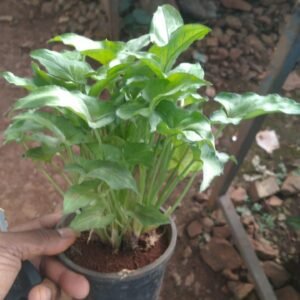The Green Rubber Plant, scientifically known as Ficus elastica (similar to its black counterpart), is a popular indoor houseplant known for its vibrant green foliage and easy care requirements. Native to Southeast Asia, particularly Indonesia and Malaysia, the Green Rubber Plant has become a favorite among plant enthusiasts for its striking appearance and air-purifying qualities. Let’s delve into the characteristics, care tips, and charm of the Green Rubber Plant.
Overview of Green Rubber Plant
The Green Rubber Plant features large, glossy, oval-shaped leaves that can grow up to 12 inches long and 6 inches wide. The deep green color of the leaves creates a lush, tropical vibe, making it an eye-catching addition to any indoor space. As the plant matures, it can reach heights of 6 feet or more, providing a bold statement in homes or offices. The Green Rubber Plant is also known for its ability to thrive in various conditions, making it an excellent choice for both novice and experienced plant caregivers.
Care and Maintenance
Caring for the Green Rubber Plant is relatively simple, allowing you to enjoy its beauty without extensive maintenance. Here are some essential tips for keeping your Ficus elastica healthy:
Light Requirements
The Green Rubber Plant prefers bright, indirect light but can tolerate low light conditions. In low light, however, the plant may grow more slowly and may not produce as many new leaves. Direct sunlight can scorch the leaves, so it’s best to place the plant near a window with filtered light or in a well-lit room.
Watering
Watering is crucial for the health of the Green Rubber Plant. Keep the soil slightly moist but not soggy. Allow the top inch of soil to dry out before watering again. During the growing season (spring and summer), the plant may require more frequent watering, while in the fall and winter months, you should reduce watering as the plant’s growth slows. Overwatering is a common issue that can lead to root rot, so it’s essential to ensure proper drainage.
Humidity
The Green Rubber Plant enjoys moderate to high humidity levels. While it can adapt to average humidity, providing higher humidity will promote healthier growth. If you live in a dry climate or during winter months, consider using a humidifier, misting the leaves regularly, or placing the pot on a pebble tray filled with water to enhance humidity.
Soil
A well-draining potting mix is ideal for the Green Rubber Plant. A standard houseplant potting mix with added perlite or orchid bark will provide good drainage and aeration for the roots. The plant prefers slightly acidic to neutral soil (pH 6.0 to 7.0).
Propagation
Propagation of the Green Rubber Plant can be done through stem cuttings. To propagate, take a healthy stem cutting with a few leaves and place it in water or soil. If using water, change it regularly to keep it fresh. Once roots develop, transfer the cutting to soil. You can also propagate by air layering, where you create a wound on a healthy stem, wrap it with moist moss, and allow roots to develop before cutting it from the parent plant.
Potential Issues
While the Green Rubber Plant is generally hardy, it can face some issues, including pests like mealybugs, spider mites, and aphids. Regularly inspect your plant for signs of infestation, and if pests are found, treat them promptly with insecticidal soap or neem oil. Additionally, watch out for overwatering, which can lead to yellowing leaves or root rot.
Aesthetic Appeal
The Green Rubber Plant is prized for its lush appearance and can serve as a striking focal point in any indoor setting. Its glossy leaves create a sophisticated ambiance, making it suitable for modern and traditional decor styles. The plant can be placed in a decorative pot on the floor, a pedestal, or even used as part of a larger indoor garden display.
Benefits of Green Rubber Plant
In addition to its beauty, the Green Rubber Plant offers several benefits:
- Air Purification: Like many plants in the Ficus genus, the Green Rubber Plant is known for its air-purifying properties. It helps filter toxins from the air, contributing to improved indoor air quality.
- Low Maintenance: Its resilience and adaptability make it an excellent choice for busy individuals or those new to plant care.






Reviews
There are no reviews yet.